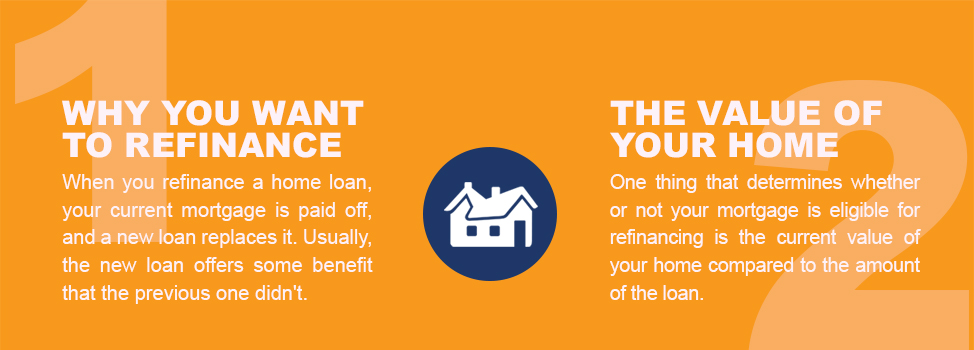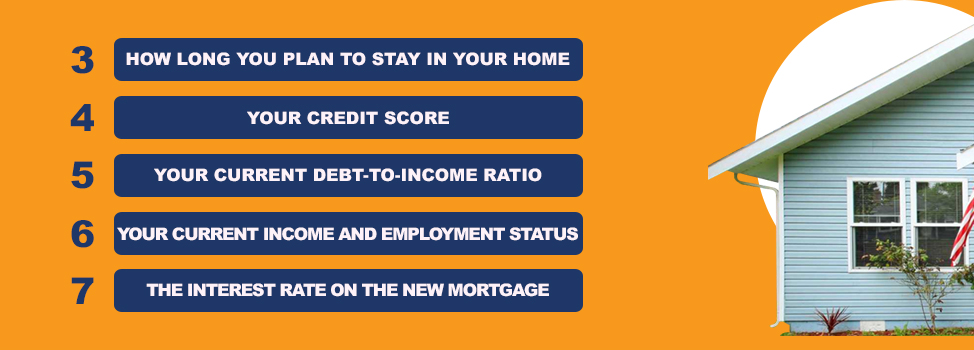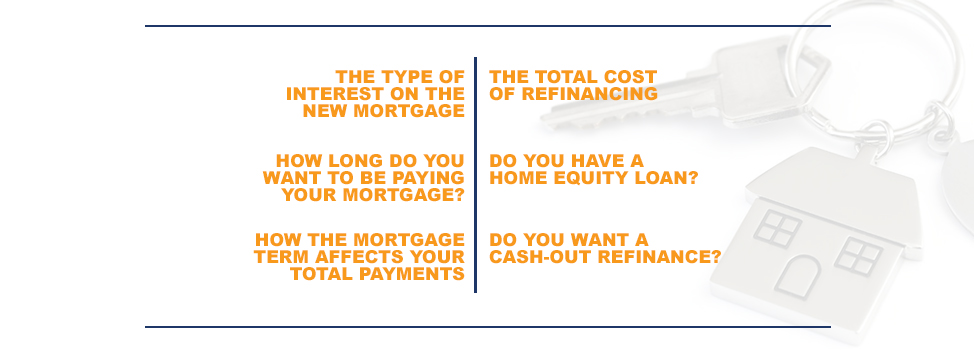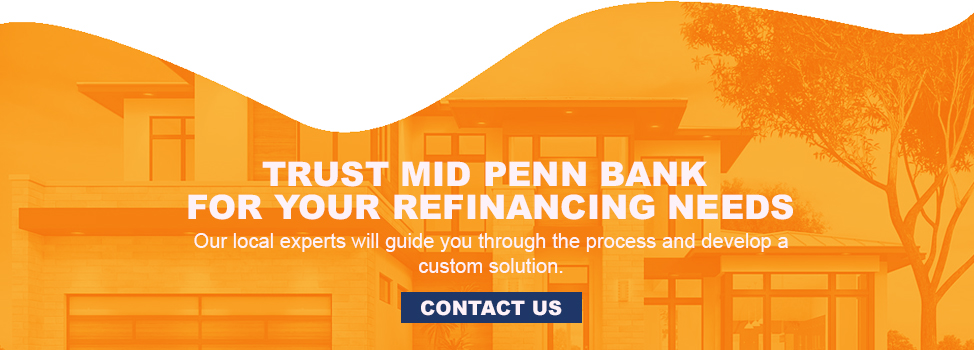13 Things to Consider When Refinancing Your Mortgage

Refinancing your mortgage can be a way to lower your monthly payments and save money over the life of your home loan. However, refinancing a home isn’t the right choice for every homeowner, as it doesn’t always lead to lower interest rates or reduced housing expenses. If you’re wondering, “Should I refinance my mortgage?”, several considerations will help you decide whether getting a new mortgage on your home is the best choice for you.
Here’s what to think about before refinancing.
13 Things to Consider to Determine if Refinancing Makes Sense for You
1. Why You Want to Refinance

When you refinance a home loan, your current mortgage is paid off, and a new loan replaces it. Usually, the new loan offers some benefits that the previous one didn’t. What that benefit is depends on your specific goals and needs. That’s why it’s a good idea to carefully consider your reasons for refinancing before you begin the process.
Common reasons for refinancing include getting a better interest rate on the loan, reducing the term of the loan, lowering monthly payments or accessing the home’s equity. Each reason has its pros and cons, so it is vital to make sure the pros outweigh the cons before you decide to go forward.
2. The Value of Your Home
One thing that determines whether or not your mortgage is eligible for refinancing is the current value of your home compared to the amount of the loan. The refinancing process typically involves an appraisal of your home, during which an independent party will visit your home and determine its market value. The appraised value of your home can make or break a plan to refinance, as the loan-to-value ratio typically shouldn’t be more than 80 percent. If your home’s value has fallen since you purchased it, you might not have enough equity built up to refinance, or you might have to bring cash to closing to make up the difference between the value of your home and the amount of the loan.
While conventional refinance mortgages usually require an appraisal of your home, not all do. The streamline refinance program from the Federal Housing Administration (FHA) and the Interest Rate Reduction Refinance Loan from the Veterans Administration (VA) don’t require an appraisal. If you are concerned that an appraisal won’t be in your favor, it can be worth your while to explore the refinancing options available from the FHA or VA, if you meet other eligibility requirements.

3. How Long You Plan to Stay in Your Home
The process of refinancing a home is similar to the process of getting a first mortgage. You’ll need to pay closing costs when you refinance. Depending on the interest rate reduction and how long you plan on living in the home, the closing costs might be more than the amount you end up saving.
It’s a good idea to think about the future before you refinance. While you might be unable to say for certain how long you’ll stay in your current home, it helps to have a ballpark figure so that you can determine whether or not you’ll be able to break even or save money by refinancing. One way to find your break-even point is to divide the total cost of the refinance by your monthly savings. If you save $150 per month and the closing costs are $4,500, it will take about 30 months, or 2.5 years, before you start to save money on your home loan. If you plan on staying in your home for more than 2.5 years, then the refinance might be worth it.
4. Your Credit Score
Your credit score can play a role in determining whether you’re approved to refinance and the interest rate you’re offered. The good news is that credit scores for refinances are typically slightly lower than the credit scores needed for purchase mortgages. According to the Ellie Mae Origination Insight Report, 72 percent of purchase loans went to people who had credit scores above 700 while only 65 percent of people had scores higher than 700 for refinance loans in July 2018. Slightly more than 21 percent of refinance loans went to people with scores between 650 and 699. Just over 25 percent of refinances were made to people with scores between 700 and 749, and just over 39 percent of refinance loans were made to people with scores over 750.
5. Your Current Debt-to-Income Ratio
Aside from your mortgage, do you have other sources of debt, such as a car loan or credit card debt? If so, they might affect your ability to refinance or the interest rate you receive. A lender will look at what’s known as your debt-to-income ratio when you apply for a refinance. Calculate your debt-to-income ratio by dividing your monthly debt payments by your gross monthly income. Usually, the debt-to-income ratio should be less than 43 percent to qualify for a mortgage or refinance.
6. Your Current Income and Employment Status
Just as you did when you applied for your first mortgage, you’ll most likely be expected to provide proof of income and employment when you apply to refinance your mortgage. If your work or income status has changed in the time since then, the change can affect your ability to refinance. If your income is higher than before, you might find that you get a better rate offered or other more favorable terms on the refinance loan. But if you’ve had a drop in income or recently changed jobs, you might have more difficulty during the refinancing process, depending on how long you’ve been at your new job or how much of a drop in income you’ve experienced. If you’ve just started a job, it can be helpful to wait a bit before you try to refinance.
It’s worth noting that government-backed loans, such as FHA and VA refinance loans, typically don’t require as much documentation as conventional refinance loans. If you’ve changed jobs or have had a drop in income, they might be an option worth pursuing, if you’re eligible.
7. The Interest Rate on the New Mortgage
One common reason for refinancing a mortgage is to qualify for a lower rate. It could be that interest rates have dropped since you got your first mortgage or your financial situation has improved enough that you qualify for a lower interest rate.
Interest rates change frequently based on the market. In July of 2017, the average interest rate on a 30-year fixed loan was 4.25 percent. By July 2018, the average interest rate on a 30-year fixed loan had climbed to 4.91 percent. If interest rates are currently higher than they were when you first got your loan, it most likely doesn’t make sense to refinance.

8. The Type of Interest on the New Mortgage
It’s not only the amount of interest you pay on a mortgage that’s worth considering when you’re thinking about refinancing. The type of interest charged can also determine whether or not refinancing makes sense for you. A mortgage with an adjustable rate might offer a low rate for the first few years of the loan. After a set period, the rate will adjust based on the market. If rates are up, your interest rate will go up. If rates are lower than when you took out your mortgage, your interest rate will drop.
If you have an adjustable rate mortgage and you foresee a sharp increase in your rate in the future, it can make sense to refinance to a loan with a fixed rate. That way, you’re able to lock in a lower rate and have the rate stay the same throughout the life of the mortgage.
9. How Long Do You Want to Be Paying Your Mortgage?
Refinancing a home is like pressing “reset” on your mortgage. Even if you’ve been paying off your current home loan for years or decades, refinancing starts the process all over again. If you refinance your existing 30-year loan into a new 30-year loan, you start back at day one when you close on the loan. That means you’ll have a new mortgage to pay for the next 30 years.
If having a mortgage for 30 more years doesn’t appeal to you, you can consider switching to a shorter term, such as 10 or 15 years. You might get a lower interest rate with a shorter-term mortgage, but the monthly payments are likely going to be higher. The trade-off is that you’ll be out of debt more quickly and might end up saving money in the long run.
10. How the Mortgage Term Affects Your Total Payments
Depending on the interest rate on your new mortgage and the term of the new mortgage, refinancing might not save you money in the long run. Some homeowners prefer to pay more over time in exchange for a lower monthly payment. To see if you’ll save money over the life of your new mortgage or not, it helps to evaluate how much you’ll spend if you keep making your current monthly payment versus how much you’ll spend if you refinance.
Your current mortgage has a balance of $100,000 with 10 years left, a fixed rate of 5.5 percent and monthly payments of $1,000. If you keep paying as agreed for the rest of the term, you’ll pay $120,000. If you refinance your mortgage to a loan with a 30-year term and an interest rate of 4.9 percent, your payments drop to $530.73 per month, which looks like considerable savings. But, over the course of 30 years, you end up paying $191,062.80.
Freeing up nearly $500 per month might be worth it to you, as it can allow you to work on other financial goals, such as paying off other debts or saving for college for your children. There are also people who’d rather pay off their mortgage as quickly as possible and pay as little in total as possible, even if it means paying more up front.
11. The Total Cost of Refinancing
You also want to think about the cost of refinancing your mortgage and whether the cost negates any savings you get from a reduced interest rate or shorter mortgage term. It’s also worth considering your options for closing costs. While it’s common to pay the fees in full at closing, some lenders offer other options to lower the upfront expense. You might be able to roll the closing costs into the principal of the mortgage so that you pay them over time. Another option is to exchange closing costs for a slightly higher interest rate on the loan. Doing so can reduce the amount you pay initially but can also reduce any benefits you get from refinancing to a loan with a lower rate.
12. Do You Have a Home Equity Loan?
If you currently have a second mortgage on your home — also called a home equity loan — or have opened a home equity line of credit (HELOC), your additional loans can interfere with the refinancing process. Having a home equity loan or line of credit won’t prevent you from refinancing, but it can complicate the situation. When you pay off your first mortgage, the holder of your second mortgage has the right to take over the spot held by the primary mortgage.
For you to refinance, the owner of your home equity loan or line of credit needs to agree to let the refinancing lender take the primary spot. Some lenders will allow it, but others won’t. If the lender who owns your home equity loan or line of credit won’t approve your refinance, you can pay off the balance on the home equity loan or try to consolidate your two mortgages into one when you refinance.
13. Do You Want a Cash-Out Refinance?
Although some homeowners refinance to save money or reduce monthly payments, many refinance as a way to tap into their home equity. A cash-out refinance results in a home loan that has a principle that’s more than the principal owed on the existing mortgage. According to statistics from Freddie Mac, 68 percent of refinances in the first quarter of 2018 were cash-out refinances and were at least five percent higher than the balance left on the first mortgage.
People use the cash from a cash-out refinance for a variety of reasons, such as paying off other debts or paying for home repairs and improvements. In that way, a cash-out refinance is similar to a home equity loan or HELOC. The big difference is that the term of a refinanced mortgage is typically much longer than the term of a home equity loan or HELOC. If you’d like to tap into the equity of your home, it can be worth comparing interest rates and terms on refinancing to the rates and terms available on a home equity line of credit to see which one would be most cost-effective.
Trust Mid Penn Bank for Your Refinance
The bottom line is there’s more to refinancing a home than meets the eye. You want to consider your overall financial goals and whether or not refinancing will help you reach them. If you live are looking to learn more about refinancing your mortgage check out the options available from Mid Penn Bank today or feel free to contact us with any questions. Also, feel free to check out our helpful “Should I refinance my mortgage?” calculator to compare proposed loan options to your current loan.
Share:
Disclosures
The material on this site was created for educational purposes. It is not intended to be and should not be treated as legal, tax, investment, accounting, or other professional advice.
Securities and Insurance Products:
NOT A DEPOSIT | NOT FDIC INSURED | NOT BANK GUARANTEED | NOT INSURED BY ANY FEDERAL GOVERNMENT AGENCY | MAY LOSE VALUE

